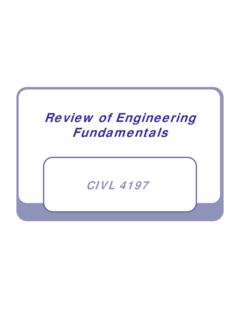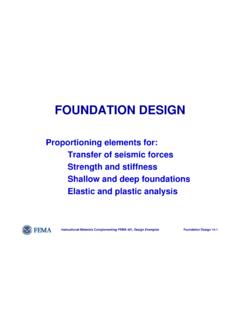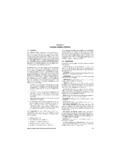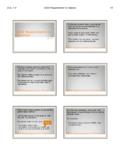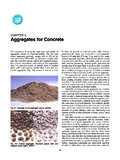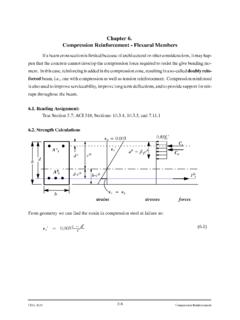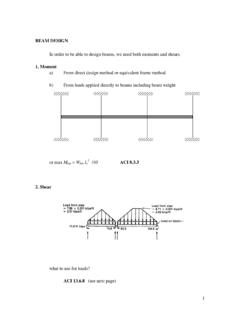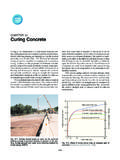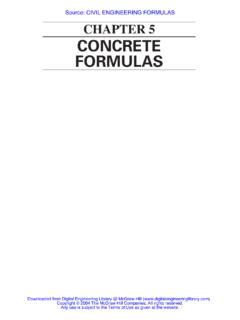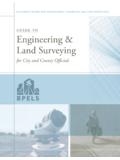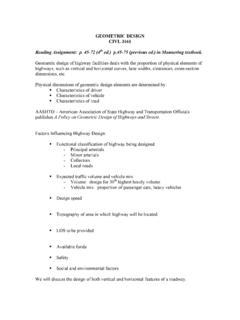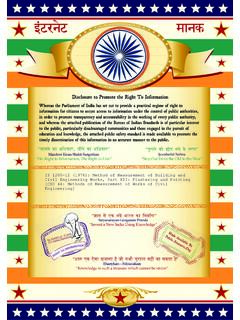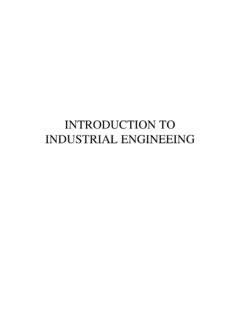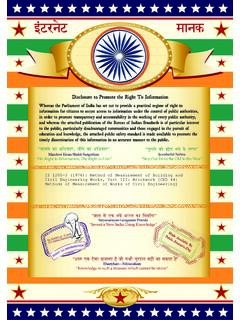Transcription of 1. Engineering Structures and Materials
1 Structures / Materials SectionPage 1 CIVL 1101 -- civil Engineering Structures and IntroductionMechanics of Materials is a branch of applied mechanics that deals with the behavior ofsolid bodies subjected to various types of loading. This field of study is known by severalnames, including Strength of Materials and mechanics of deformable bodies. The solidbodies considered in this book include axially loaded members, shafts in torsion, thin shells,beams, and columns, as well as Structures that are assemblies of these components. Usuallythe objectives of our analysis will be the determination of the stresses, strains, and deflectionsproduced by the loads. If these quantities can be found for all values of load up to the failureload, then we will have a complete picture of the mechanical behavior of the thorough understanding of mechanical behavior is essential for the safe design of allstructures, whether buildings and bridges, machines and motors, submarines and ships, orairplanes and antennas.
2 Hence, mechanics of Materials is a basic subject in many engineeringfields. Of course, statics and dynamics are also essential, but they deal primarily with theforces and motions associated with particles and rigid bodies. In mechanics of Materials , wego one step further by examining the stresses and strains that occur inside real bodies that de-form under loads. We use the physical properties of the Materials (obtained from experi-ments) as well as numerous theoretical laws and concepts, which are explained in succeedingsections of this analyses and experimental results have equally important roles in the study ofmechanicsof Materials . Onmanyoccasions, wewill makelogical derivationstoobtainformu-lasand equationsfor predictingmechanical behavior, but wemust recognizethat theseformu-las cannot be used in a realistic way unless certain properties of the Materials are properties are available to us only after suitable experiments have been carried out inthe laboratory. Also, because many practical problems of great importance in engineeringcannot be handled efficiently by theoretical means, experimental measurements become historical development of mechanics of Materials is a fascinating blend of both theoryand experiment; experiments have pointed the way to useful results in some instances, andtheory has done so in others.
3 Such famous men as Leonardo da Vinci(1452-1519) and GalileoGalilei (1564-1642) performed experiments to determine the strength of wires, bars, andbeams, although they did not develop any adequate theories (by today s standards) to explaintheir test results. Such theories camemuch later. Bycontrast, thefamous mathematicianLeon-hard Euler (1707-1783) developed the mathematical theory of columns and calculated thetheoretical critical load of a column in 1744, long before any experimental evidence existed toshow the significance of his results. Thus, for want of appropriate tests, Euler s results re-mained unused for many years, although today they form the basis of column SectionPage 2 CIVL 1101 -- civil Engineering MeasurementsWhen studying mechanics of Materials from this book, you will find that your efforts aredivided naturally intotwoparts: first, understanding the logical developmentof theconcepts,and second, applying those concepts to practical situations. The former is accomplished bystudying the derivations, discussions, and examples, and the latter by solving of the examples and problems are numerical in character, and others are algebraic torsymbolic).
4 An advantage of numerical problems is that the magnitudes of all quantities areevident at every stage of the calculations. Sometimes these values are needed to ensure thatpractical limits (suchas allowable stresses) are not exceeded. Algebraicsolutions have certainadvantages, too. Because they lead to formulas, algebraic solutions make clear the variablesthat affect the final result. For instance, a certain quantity may actually cancel out of the solu-tion, a fact that would not be evident from a numerical problem. Also apparent in algebraicsolutionsisthemannerin whichvariables affectthe results, such asthe appearanceof onevari-able in the numerator and another in the denominator. Furthermore, a symbolic solution pro-vides the opportunity to check the dimensions at any stage of the work. Finally, the most im-portant reason for obtaining an algebraic solution is to obtain a general formula that can beprogrammed on a computer and used for many different problems. In contrast, a numericalsolution applies to only one set of circumstances.
5 Ofcourse, youmust beadept atboth kindsofsolutions, hence you will find a mixture of numerical and algebraic problems throughout problems require that you work with specific units of measurements. The twoaccepted standards of measurement are the. International System of Units (SI) and the System (USCS). As you know significant digits are very important in our work in this section,three significant digitsprovides enough Normal Stress and StrainThe fundamental conceptsof stressand strain can be illustrated by considering aprismat-ic bar that is loaded by axial forcesPat the ends, as shown in Figure 1. Aprismatic baris astraight structural member having constant cross section throughout its length. In this il-lustration, theaxial forcesproduce auniform stretchingof thebar; hence, the baris said to investigate the internal stresses produced in the bar by the axial forces, we make animaginary cut at sectionaa(Figure 1). This section is taken perpendicular to the longitudinalaxis of the bar; hence, it is known as across section.
6 We now isolate the part of the bar to therightofthecutasafreebody. The tensileloadPacts atthe righthand end ofthe freebody; attheother end are forces representing the action of the removed part of the bar upon the part thatremains. These forces are continuously distributed over the cross section, analogous to thecontinuous distribution of hydrostatic pressure over a submerged horizontal surface. The in-tensity of force (that is, the force per unit area) is called thestressand is commonly denoted bythe Greek letter (sigma). Assuming that the stress has a uniform distribution over the crosssection (see Figure 1), we can readily see that its resultant is equal to the intensity times theStructures/ Materials SectionPage 3 CIVL 1101 -- civil Engineering MeasurementsFigure 1. Bar in tension. LPxPPaaPaa dcross-sectional areaAof the bar. Furthermore, from the equilibrium (balancing of forces) ofthe body shown in Figure 1, it is also evident that this resultant must be equal in magnitudeand opposite in direction to the applied loadP.
7 Hence, we obtain =PA(1--1)as the equation for the uniform stress in an axially loaded, prismatic bar of arbitrary cross-sec-tional shape. When the bar is stretched by the forcesP, as shown in the figure, the resultingstresses aretensile stresses; if the forces are reversed in direction, causing the bar to be com-pressed, weobtaincompressive stresses. Inasmuchas thestress aacts ina directionperpendic-ular to the cut surface, it is referred to as anormal stress. Thus, normal stresses may be eithertensile or compressive stresses. Later, we will encounter another type of stress, called ashearstress, that acts parallel to the asign conventionfor normal stresses is required, it is customary to define tensilestresses as positive (+) and compressive stresses as negative (--).Because the normal stress is obtained by dividing the axial force by the cross-sectionalarea, it hasunitsof force per unit of area. When SI units are used, force is expressed in newtons(N) and area in square meters (m2).
8 Hence, stress has units of newtons per square meterStructures/ Materials SectionPage 4 CIVL 1101 -- civil Engineering Measurements(N/m2), or pascals (Pa). However, the pascal is such a small unit of stress that it is necessary towork with large multiples. To illustrate this point, we have only to note that it takes almost7000 pascals to make 1 an example, a typical tensile stress in a steel bar might have a magnitude of 140 mega-pascals (140 MPa), which is 140 x 106pascals. Other unitsthatmay be convenient touse are thekilopascal (kPa) and gigapascal (GPa); the former equals 103pascals and the latter equals 109pascals. Although it is not recommended in SI, you will sometimes find stress given in new-tons per square millimeter (N/mm2), which is a unit identical to the megapascal (MPa).When using USCS units, stress is customarily expressed in pounds per square inch (psi) orkips per square inch (ksi). One kip, or kilopound, equals 1000 pounds. For instance, a typicalstress in a steel bar might be 20,000 psi or 20 order for the equation =P/Ato bevalid, thestress mustbeuniformly distributedoverthe cross section of the bar.
9 This condition is realized if the axial forcePacts through the cen-troid of the crosssectional area. When the loadPdoes not act at the centroid, bendingof thebarwill result, and a more complicated analysis is necessary (you will learn more in CIVL 3322 Strength of Materials ). However, we will assume throughout our discussions that all axialforces are applied at the centroid of the cross section unless specifically stated uniform stress condition pictured in Figure 1 exists throughout the length of the mem-berexceptnear theends. The stressdistribution atthe endsof thebar dependsupon thedetailsof how the axial loadPis actually applied. If the load itself is distributed uniformly over theend, then the stress pattern at the end will be the same as elsewhere. However, the load is usu-ally concentrated over a small area, resultingin high localized stresses and nonuniform stressdistributions over cross sections in the vicinity of the load. As we move away from the ends,the stress distribution gradually approaches the uniform safe toassume thatthe formula =P/Amay be used with good accuracy at anypoint within the bar that is at least a distancedaway from the ends, wheredis the largest trans-verse dimension of the bar (see Figure 1).
10 Of course, even when the stress is not uniform, theequation =P/Awill give theaverage normal axially loaded bar undergoes a change in length, becoming longer when in tension andshorter when in compression. The total change in length is denoted by the Greek letter (del-ta) and is pictured in Figure 1 for a bar in tension. This elongation is the cumulative result ofthe stretching of the material throughout the lengthLof the bar. Let us now assume that thematerial is the same everywhere in the bar. Then, if we consider half of the bar, it will have anelongation equal to /2; similarly, if we consider a unit length of the bar, elongation equal to1/Ltimes the total elongation . In this manner, we arrive at the concept of elongation per unitlength, orstrain, denoted by the Greek letter (epsilon) and given by the equation = L(1--2) Structures / Materials SectionPage 5 CIVL 1101 -- civil Engineering MeasurementsIf the bar is in tension, the strain is called atensile strain, representing an elongation orstretchingofthe material.
